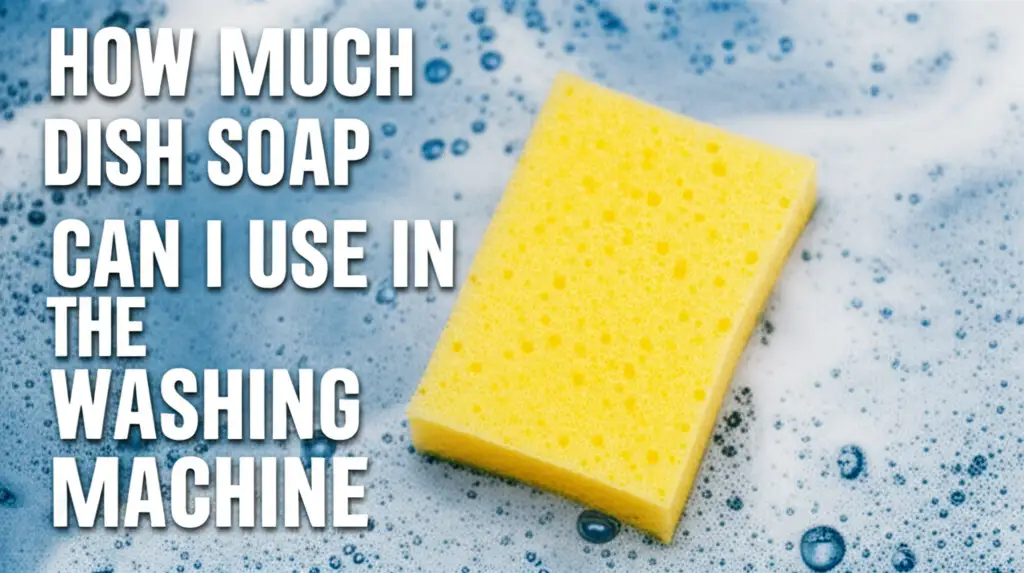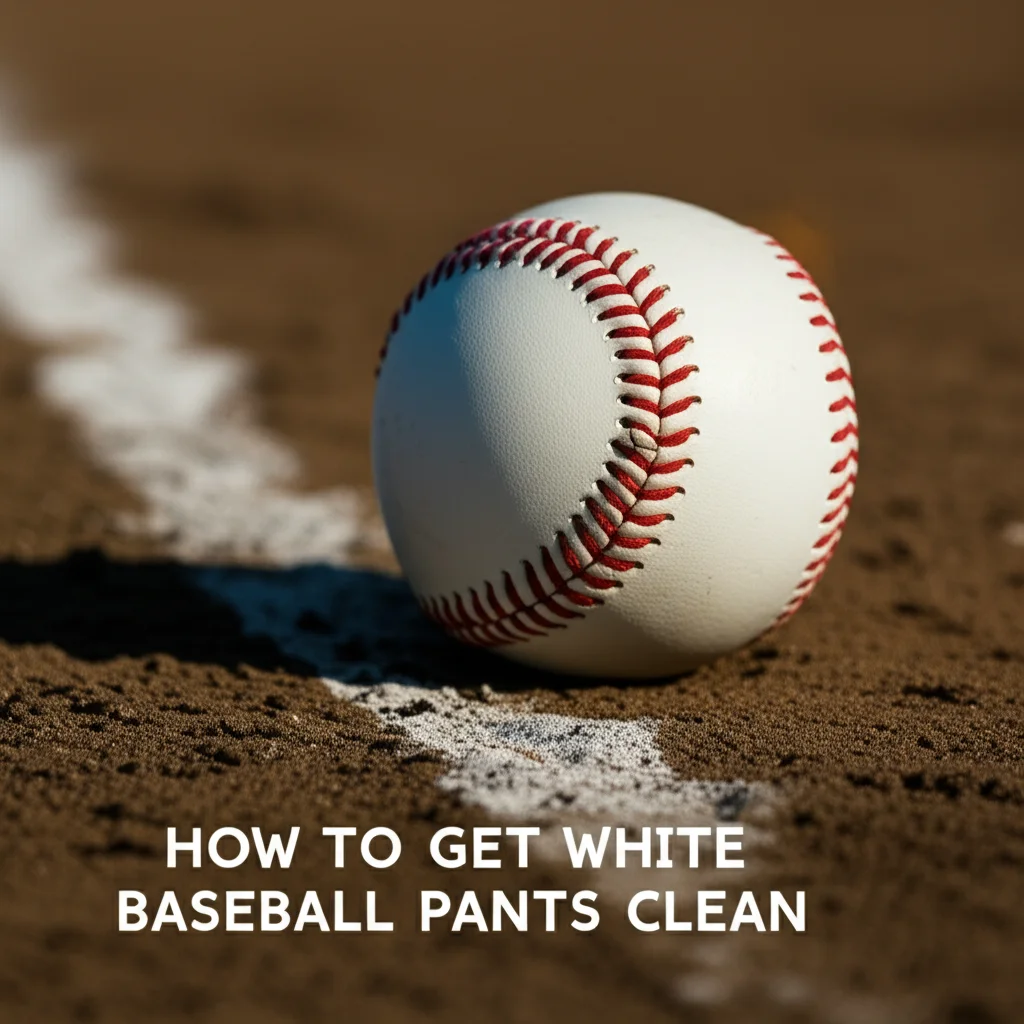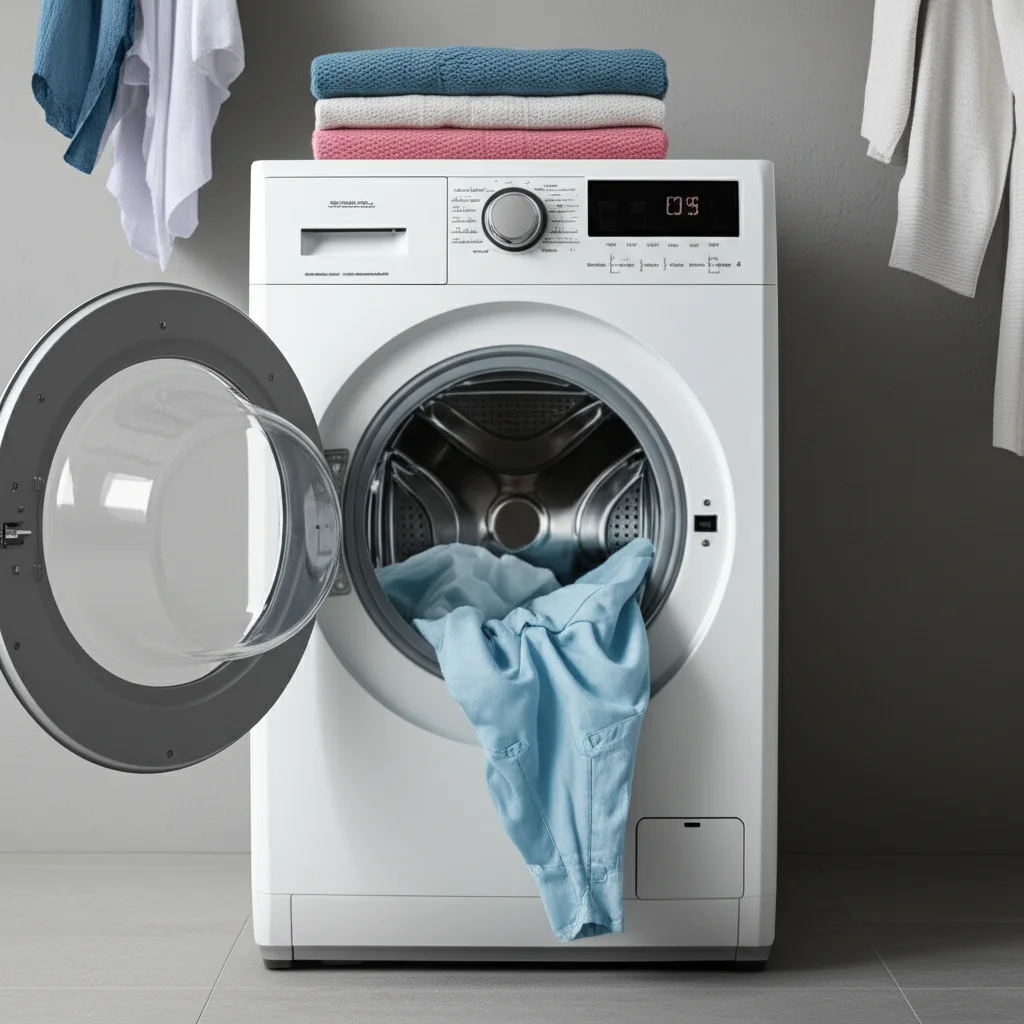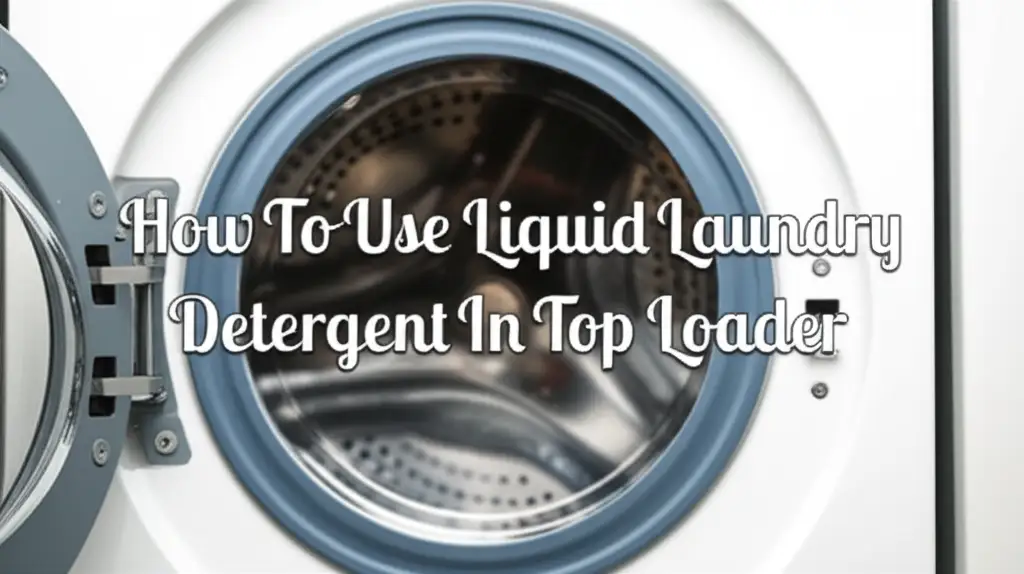· Davia Murnell · Laundry Care · 15 min read
How Much Dish Soap Can I Use In The Washing Machine

How Much Dish Soap Can I Use In The Washing Machine
Have you ever stared at a pile of dirty laundry, only to realize you’re completely out of laundry detergent? It is a common household dilemma. Your eyes might drift to the dish soap on the counter, thinking, “Soap is soap, right?” This thought is tempting, especially when faced with an urgent wash.
Many people consider using dish soap as a quick fix. They wonder if it can clean clothes just as well. However, dish soap and laundry detergent are made for different purposes. Using the wrong soap in your washing machine can lead to major problems. This article explores why dish soap is not ideal for laundry and what can happen if you use it. We will also discuss safer alternatives and proper washing machine care.
Takeaway
- Avoid Dish Soap: Do not use dish soap in your washing machine as a substitute for laundry detergent.
- Excessive Suds: Dish soap creates too many suds, causing overflow and potential machine damage.
- Residue Buildup: It leaves a sticky residue on clothes and in the machine, attracting dirt and mold.
- Machine Damage Risk: High suds can strain motor, clog drains, and damage internal components.
- Emergency Use Only (Tiny Amount): If absolutely necessary for a spot stain, use a single drop directly on the stain, then rinse well before washing with proper detergent.
If you find yourself asking, “How much dish soap can I use in the washing machine?” the simple answer is: virtually none. Dish soap is designed for manual dishwashing or dishwashers, creating abundant suds to cut grease. Washing machines require low-sudsing detergents to prevent overflows, residue buildup, and potential damage to the appliance’s intricate systems.
Understanding the Difference Between Dish Soap and Laundry Detergent
It might seem logical to use any cleaning agent in a washing machine, but dish soap and laundry detergent are formulated differently. Each product serves a distinct purpose. Dish soap works by creating a lot of suds. These suds break down grease and food particles on dishes.
Laundry detergent, on the other hand, is low-sudsing. It is designed to clean fabrics without creating excessive foam. The cleaning action in laundry detergent comes from its powerful enzymes and surfactants, not primarily from suds. Using dish soap in a washing machine will lead to a massive foam party you did not invite.
The primary difference lies in their sudsing agents. Dish soap is optimized for high suds production, which helps lift food from dishes. Washing machines, however, rely on mechanical agitation and proper rinsing cycles to clean clothes. Too many suds hinder this process. Excessive foam can prevent clothes from tumbling correctly. This stops them from getting clean.
Moreover, dish soap can leave a sticky residue. This residue attracts more dirt to your clothes over time. It can also cause skin irritation for those with sensitive skin. Laundry detergents are formulated to rinse away cleanly, leaving clothes fresh and free of residue. Understanding these differences is the first step in avoiding laundry disasters.
The Dangers of Using Too Much Dish Soap in Your Washing Machine
Using even a small amount of dish soap in your washing machine can lead to big problems. The most immediate and noticeable issue is excessive suds. These suds will quickly fill the drum and overflow, spilling onto your laundry room floor. This creates a messy and potentially hazardous situation.
Beyond the immediate mess, persistent use of dish soap can cause long-term damage to your appliance. The motor of your washing machine is not designed to handle high levels of foam. Excessive suds put a strain on the motor as it tries to spin through the thick foam. This can lead to motor burnout or premature wear and tear.
The suds can also clog the machine’s drain pump and hoses. This prevents proper drainage and can lead to water pooling in the drum. Over time, this constant struggle can cause your machine to malfunction or break down completely. Repairing a washing machine can be expensive. Replacing it is even more so. You can learn more about proper appliance care, including how to fix common issues, by exploring resources on why does my beko washing machine leak from the soap dispenser. This link offers insights into potential leak causes, some of which could be related to improper soap use.
Another significant danger is the residue that dish soap leaves behind. Unlike laundry detergent, dish soap is not designed to rinse cleanly from fabrics in a washing machine cycle. This sticky residue can build up on your clothes, making them feel stiff or attracting more dirt over time. It also accumulates inside the washing machine drum, hoses, and dispenser. This sticky film creates a breeding ground for mold and mildew, leading to unpleasant odors and potentially damaging your machine’s internal components.
What Happens If You Accidentally Use Dish Soap
It happens to the best of us: you are distracted or in a hurry and accidentally pour dish soap into the washing machine. The first thing you will likely notice is an overwhelming amount of suds. As the wash cycle begins, foam will quickly build up, sometimes reaching alarming levels. It can even overflow from the detergent dispenser, the drum, or even the air vents.
If this happens, do not panic. Your immediate action should be to stop the machine. Turn it off as soon as you see the suds building up excessively. This prevents the overflow from getting worse and reduces strain on the machine. Open the door if it is a top-loader, or wait for the door to unlock on a front-loader.
Once the machine is off, the next step is to remove the suds. You can scoop out as much foam as possible. Then, run a rinse and spin cycle, or even several rinse cycles, without adding any more soap. This helps to flush out the remaining suds and residue. You might need to repeat this process multiple times until the water runs clear and there are no more visible suds. For insights on maintaining your machine, particularly its filter after such incidents, consider reading about how to clean washing machine filter, as suds can sometimes affect its performance.
After the suds are gone, it is wise to run an empty hot water cycle with a cup or two of white vinegar. Vinegar is excellent for breaking down soap residue and deodorizing the machine. This helps to clean the internal components and prevent future problems. For more detailed instructions on cleaning your washing machine with vinegar, you can refer to articles like how to clean washing machine with vinegar. This extra step ensures that your machine is thoroughly cleansed and ready for its next proper laundry cycle.
Emergency Measures: When a Tiny Drop Might Be Considered
There are very few scenarios where a tiny amount of dish soap might be considered, and these are typically for spot treatments, not for a full wash cycle. For instance, if you have a very greasy stain on a garment, a single, tiny drop of dish soap applied directly to the stain can act as a powerful degreaser. Dish soap excels at breaking down oils and fats. This makes it effective for pre-treating specific soiled areas.
To do this, apply just one drop to the greasy spot. Gently rub it in with your finger or a soft brush. Let it sit for a few minutes. Then, rinse the garment thoroughly under running water to remove the dish soap and the lifted grease. The key here is to rinse it before putting the item into the washing machine. You must ensure almost all the dish soap is gone. If you are dealing with tough oil stains, further guidance can be found on how to remove them by checking resources like how to get oil out of washing machine, which focuses on machine cleaning but hints at the challenge of oil.
Never add dish soap directly into the washing machine’s dispenser or drum for an entire load. Even if you are trying to target a single greasy item, pre-treating it separately is crucial. Adding dish soap to the wash cycle, even a small amount, risks creating too many suds. This can still lead to the problems discussed earlier, such as overflows and machine strain. Always err on the side of caution. Laundry detergent is specifically formulated for the washing machine environment.
Remember, this is an emergency measure for spot treatment only. It is not a substitute for proper laundry detergent. If you are out of laundry detergent, it is always better to wait until you can get proper detergent. You can also explore safer alternatives instead of risking your appliance and clothes with dish soap. Always prioritize the health of your washing machine and the longevity of your clothes.
Safer Alternatives to Dish Soap for Laundry
Running out of laundry detergent can be frustrating, but there are safer alternatives than reaching for dish soap. Many household items can effectively clean clothes without causing sudsing issues or machine damage. One popular and effective substitute is baking soda. A half-cup to a full cup of baking soda added to your wash cycle can help clean and deodorize clothes. It works as a natural cleanser and water softener.
Another excellent alternative is white vinegar. Adding half a cup of white vinegar to the fabric softener dispenser can help remove odors, brighten whites, and soften fabrics. It also helps to break down mineral buildup in your machine. Vinegar is particularly useful if you have hard water. For general guidance on what safe alternatives you can add to your machine, resources like what to add to washing machine provide a broader perspective on suitable additives.
For a gentle hand wash, you can use a small amount of mild shampoo (like baby shampoo) or even body wash. These products are usually designed for skin and hair, so they are less harsh on fabrics and produce fewer suds than dish soap. Always use them in very small quantities and rinse thoroughly if handwashing. Remember, these are for emergency handwashing, not for machine use.
If you are looking for long-term solutions, consider making your own laundry detergent. Many recipes use ingredients like borax, washing soda, and soap flakes. These DIY detergents are usually low-sudsing and cost-effective. They give you control over the ingredients. While these alternatives are safer than dish soap, they might not offer the same cleaning power as commercial laundry detergents, especially for heavily soiled items. Always prioritize using proper laundry detergent when possible for optimal results and machine longevity.
Cleaning Your Washing Machine After a Dish Soap Incident
If you have mistakenly used dish soap in your washing machine, a thorough cleaning is essential. This helps remove residue and prevents mold, odors, and future machine problems. The first step is to run multiple empty rinse cycles with just water. This helps flush out excess suds and soap film from the drum and hoses. Keep running cycles until no more suds appear.
After the rinse cycles, a deep cleaning with white vinegar is highly recommended. Add two to four cups of distilled white vinegar directly into the detergent dispenser or the drum. Then, run a hot water cycle, preferably on the longest setting. Vinegar helps to cut through soap scum and residue, neutralize odors, and kill mold and mildew spores. For a complete guide on how to clean your washing machine effectively, including specific tips for different components, you might find valuable information on how to clean your washing machine inside. This comprehensive resource covers various cleaning methods for a well-maintained appliance.
You should also physically clean the dispenser drawer. Dish soap leaves a sticky film here. Pull out the dispenser drawer if it is removable. Soak it in hot, soapy water (using dish soap for this purpose is fine, just not in the machine drum). Scrub away any residue. Use a small brush or old toothbrush to clean the nooks and crannies inside the dispenser housing where the drawer sits. These areas often harbor mold and mildew, especially after soap buildup.
Finally, wipe down the drum and the rubber gasket around the door (for front-loaders) with a clean cloth. Pay special attention to the gasket, as it tends to trap water and residue, leading to mold growth. Leaving the washing machine door ajar after use helps air circulation and prevents mold. Regular maintenance and prompt cleaning after any soap mishap will keep your washing machine running smoothly and smelling fresh.
Preventing Future Laundry Detergent Mishaps
Preventing future laundry detergent mishaps is simple once you establish a few good habits. The most straightforward solution is to keep your laundry detergent in an easily accessible and clearly designated spot near your washing machine. This minimizes confusion when you are in a hurry or distracted. Store dish soap in a completely different area, perhaps under the kitchen sink, far away from the laundry supplies.
Another helpful tip is to buy your laundry detergent in bulk. This way, you always have a backup supply. Running out of detergent is a primary reason people look for alternatives. Having an extra bottle on hand reduces the temptation to use substitute products. When you are low, make a note to buy more before you completely run out.
Educate everyone in your household about the correct use of the washing machine. Make sure every family member knows which product goes where. Children, in particular, should be taught not to touch laundry products without supervision. Label your detergents clearly if you have multiple types or homemade solutions. This simple step can prevent confusion and accidental misuse.
Finally, consider using pre-measured laundry detergent pods or strips. These eliminate the need for pouring liquid or powder, reducing the chance of using the wrong product or too much of the right one. They are convenient and mess-free. By adopting these simple preventative measures, you can ensure your washing machine remains in good condition and your clothes are always cleaned correctly with the appropriate products.
FAQ Section
Q1: Can I use just a tiny bit of dish soap in my washing machine? A1: No, it is strongly advised against using even a tiny bit of dish soap in your washing machine. Dish soap creates excessive suds not suitable for washing machines. This can cause overflows, clog drains, and put undue stress on the machine’s motor. Always use laundry detergent designed for your machine.
Q2: What happens if dish soap suds overflow from the washing machine? A2: If suds overflow, immediately stop the machine. Scoop out as much foam as you can. Then, run multiple rinse and spin cycles without adding any more soap. This helps to flush out the excess suds. You may also need to wipe down the surrounding area to prevent slips or water damage.
Q3: Can dish soap damage my clothes? A3: Yes, dish soap can damage your clothes over time. It leaves a sticky residue on fabrics because it is not designed to rinse cleanly in a washing machine. This residue can attract more dirt, make clothes feel stiff, and potentially cause skin irritation. It can also dull colors or leave streaks.
Q4: Is it safe to use dish soap for handwashing clothes? A4: For handwashing, a very small amount of mild dish soap can be used for tough grease stains, but it should be rinsed very thoroughly. It’s not ideal for general handwashing, as it can be harsh on fabrics and skin. For general handwashing, mild shampoo or specialized hand wash detergents are better choices.
Q5: How can I remove dish soap residue from my washing machine? A5: To remove dish soap residue, first, run several empty rinse cycles. Then, add 2-4 cups of white vinegar to the detergent dispenser or drum and run a hot water cycle. You should also manually clean the detergent dispenser and the rubber gasket with a cloth and warm water to remove any lingering film.
Conclusion
While the idea of using dish soap in your washing machine might seem like a clever hack when you’re out of laundry detergent, it is a solution that comes with significant risks. As we have explored, dish soap creates far too many suds for a washing machine. This can lead to messy overflows, residue buildup on your clothes, and potentially costly damage to your appliance’s motor and drainage system. My advice is simple: always use laundry detergent designed for your washing machine.
Accidental dish soap use requires immediate action, including stopping the machine and running multiple rinse cycles, followed by a thorough cleaning with vinegar. This helps protect your appliance and keep it running efficiently. Remember, for the best results and to maintain the longevity of your washing machine and clothes, stick to products specifically formulated for laundry. For general advice on keeping your machine spotless, refer to guides like how to clean your washing machine inside.
Prevention is always better than a cure. Keep your laundry supplies well-stocked and separate from your dish soap. Learn about safer alternatives like baking soda or vinegar for emergencies. By understanding why how much dish soap can I use in the washing machine is a trick question (the answer being “almost none”), you can ensure your laundry days remain stress-free and your appliances stay in top condition. Take care of your washing machine, and it will take care of your clothes for years to come.





